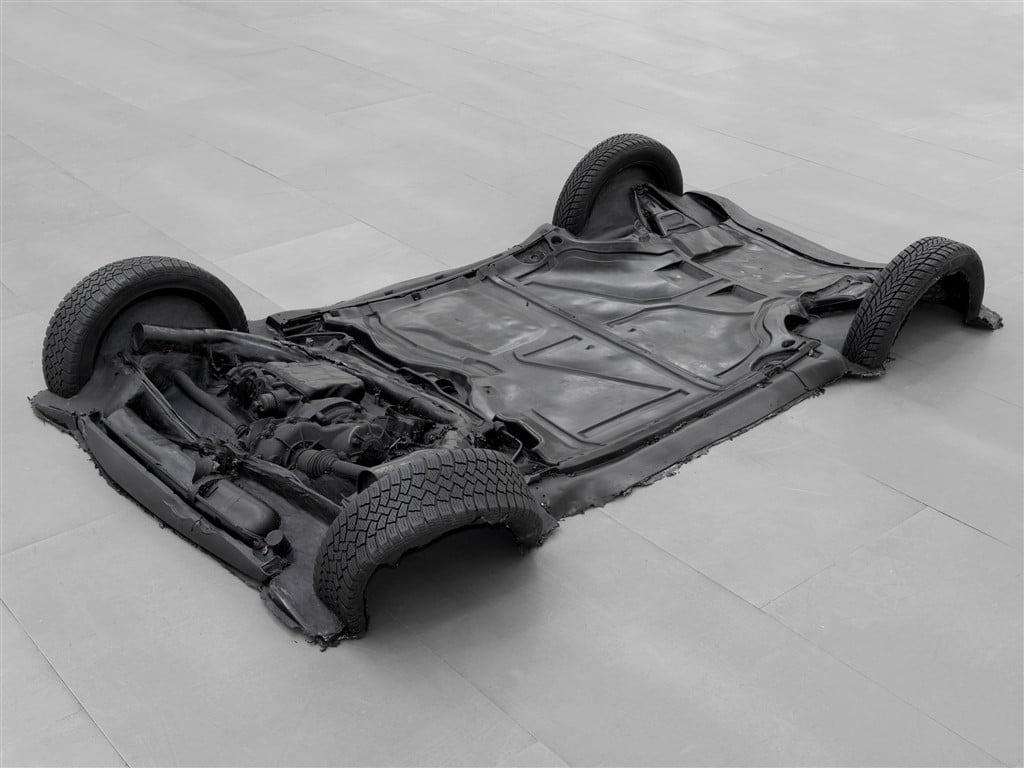
carlier | gebauer is pleased to announce the second solo exhibition by
German artist Asta Gröting. Creating enigmatic sculptures, Asta
Gröting’s work explores the expressive properties of various materials
(silicon, bronze, polyester, polyurethan) and their relationship to
form through a complex system that intertwines intimacy, history and
memory.
For this exhibition, Asta Gröting features three new large-scale
sculptures – produced from traditional sculptural casts with material
such as polyurethan – entitled: Die Reisekutsche von Goethe, Der
Mercedes von Adenauer and Mein smart. The exhibition also includes two
older works Space between two people having sex (2008, silicon, 77 x 52
x 106 cm) and Abformung einer Familie (2011, bronze, 56 x 90 x 90 cm),
which delicately map the character and thematic development of this
exhibition. These works invite the visitor to wander in the maze of
memory where all the works metaphorically refer to the «human
proportions» according to Asta Gröting’s words.
In her artistic practices, which she has developed since the middle of
the 1980s, Asta Gröting works through the diversity of these tangible
forms and materials, showing us the evolution and complexity of social
forms of life, whether romantic, familial, cultural or mechanical as
many meetings of bodies in space. As she said, in Space between two
people having sex, the visitor faces «the void between two people along
with all the unexpressed, inexpressible and hidden issues that
relationships involve».
With her most recent works, the underside casted of Goethe’s travelling
carriage (2012, 60 x 140 x 330 cm, polyurethan), Adenauer’s Mercedes
(2012, 45 x 200 x 520 cm, polyurethan) and the own ride of the artist‘s
smart (2012, 50 x 155 x 260 cm, polyurethan), she keeps creating
physical representation of normally unseen elements «in order to be
able to focus on the immaterial» that we can’t see because we can’t or
don’t want to perceive them in dailylife. Thus, in this exhibition, we
discover that the objects can just live by their absence, by the void
and the print they left, by the solitude they provoke.
Frozen in the materiality of polyurethan, lying in the space like
immobilised, these three means of transport that represent the
carriage, the mercedes and the smart refer us to times, activities
(literary, political and artistic) and figures of German culture
eminently different, respectively associated to Johann Wolfgang von
Goethe, Konrad Adenauer and Asta Gröting. Beyond a simple
representation of history of wheeled vehicles, it is a fragment of
German culture that is given to us to see here in the form of a dark
gripping triptych, three tombs, three monuments whom the uncanny
violent and calm amplifies the tension of the installation and
transports us into a more sensitive area, a zone of silence where times
mingle and disappear at the same time.
In the continuity of her organic works, these three negative car frames
refer us to our own internal organ, the belly, place of all emotions,
well known to be our second brain or place of soul, part of our body
particularly sensitive and fragile that we protect in case of any
attack or fight ; this is from where we can die but it is also, in the
animal kingdom, the most intimate part that is given to us, to caress
in privileged moments of tenderness and complete confidence with
someone. In the Middle Ages believes – which thought the soul as an
organ – we could see the three casts of Goethe’s travelling carriage,
Adenauer’s official car and the own ride of the artist as autopsies to
find their soul. In this way, her works keeps combining the inside and
the outside, making the invisible visible always related to the human
psyche.
Above the huge materiality of these sculptures, the evanescent silicon
of two lovers, the bronze stability of the family and the weak density
of the rubber of the internal machinery of the massive vehicles, Asta
Gröting keeps showing us things that can’t normally be seen and also
perhaps those which we don’t really want to see, the intimate moments
of two people or family relationships, or the car frames, the
invisibility of material elements, of unspoken feelings. Both in the
former than in the new works, the artist puts the visitor in presence
of the «hidden processes visible», of the tension of the installation
and reveals her inexhaustible questioning of the psychic and emotive
depth of self-construction and the underlying conditions of human
existence.